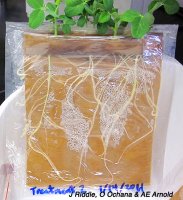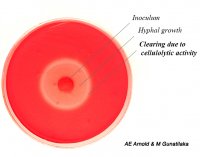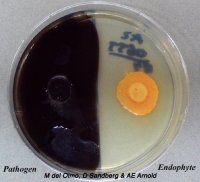Functional
Dimensions of Biodiversity: An Interdisciplinary Study of Hyperdiverse Endophytic Fungi and their Function in Boreal Forests
Aim 3: Empirically assess functional diversity of endophytes
For additional information, contact Georgiana May (gmay@umn.edu) and Betsy Arnold(Arnold@ag.arizona.edu)
Genera containing saprotrophic or pathogenic species often contain endophytes as well. Coupled with isolation of morphologically similar fungi from healthy, dead, and diseased tissue, these observations suggest that endophytes may encompass latent abilities to decay plant material and cause disease. However, overlap among these ecological modes may be overestimated when fine-scale functional and genetic variation is obscured by convergent or uninformative morphology -- and increasingly, by simple BLAST matches or phylogenetic analyses with only limited ecological, geographic, and taxonomic sampling.
Our preliminary phylogenetic studies suggest that endophytism is a labile phenotype with frequent transitions to and from pathogenicity, and that saprotrophic lineages represent largely distinct evolutionary trajectories. However, such studies have relied on “best estimates” of ecological mode – usually inferred from the substrate in which strains were isolated, rather than from assessments of functional traits. These issues can only be resolved through empirical assays of functional diversity.
Enabled by our extensive surveys and phylogenetic- and population-genetic framework, we will select strains to assess endophyte functional traits (this aim) and the genetic diversity underlying them (Aim 4), with a focus on (1) substrate utilization, focusing on carbon and nitrogen use in vitro; (2) functional traits relevant to ecology, focusing on enzyme activity and tissue degradation in vitro; (3) host breadth and interaction mode, using plant- and photobiont bioassays; and (4) secondary metabolite production.








